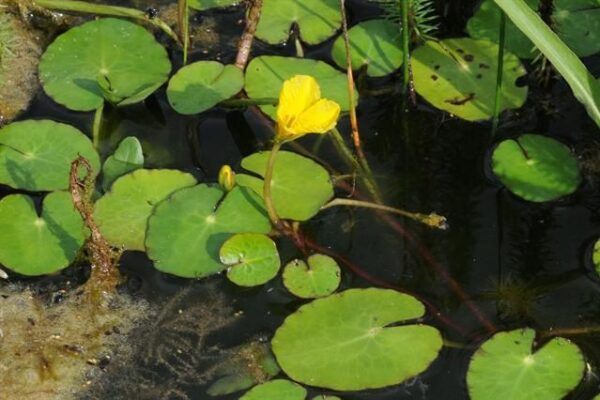Yellow Floating Heart

Species at a Glance
The yellow floating heart (Nymphoides peltata) is an aggressive aquatic perennial that was introduced as a garden ornamental from eastern Asia that has since spread throughout the United States and Canada. It forms dense mats of vegetation in the water that exclude native species and alter the ecology of waterways.
Identification
The leaves are shiny, green, heart-shaped or nearly circular, up to 5-15 cm (2-6 inches) long, and are set on stalks that float at the water’s surface. Leaves are frequently seen with reddish-purple blotches and are slightly wavy or rippled. They are alternately arranged along the main stem, and oppositely arranged on the flower stems.
Flowers bloom from June to October and are produced on stalks just above the water’s surface. They can be either solitary or in clusters of up to five, with five yellow petals that have distinctive fringed edges, as well as five sepals, and five stamens.
The yellow floating heart produces fruit capsules (2.5 cm or 1-inch) that contain numerous flat, oval seeds with “hairy” edges. When ripe, they split open, releasing the seeds to float on the surface of the water. The yellow floating heart is bottom-rooted with long branched stems that reach about 1 m (3 ft) or more.
Similar Species
Yellow floating heart may be confused with the native spatterdock (Nuphar variegate) or watershield (Brasenia chreberi). Spatterdock has larger leaves that grow to 30 cm (12 in) or more and has yellow flowers in the shape of a ball with six or more petals. Watershield has distinctive oval-shaped leaves, an inconspicuous purple flower, and can be easily recognized by a gelatinous slime that covers the stem and underside of the leaves.
Habitat
Most commonly found in slow moving waters about 0.5-4 m (1.5-13 ft) deep, such as rivers, lakes, reservoirs, ponds, and swamps, and can even grow on damp mud.
Spread
Because of its popularity in the aquarium trade, yellow floating heart can be easily purchased in water garden specialty stores and online.. Spread can occur when it escapes outdoor water gardens during flooding events, or when it is intentionally discarded into waterways. Since it spreads both by seed and fragmentation, pieces of plant and stiff seed hairs can be moved to new areas on water currents, or as they hitchhike on the feathers or fur of waterfowl and other wildlife.
Distribution
Native to Eurasia and the Mediterranean region, yellow floating heart was introduced as an ornamental plant from eastern Asia. In the Mid-Atlantic region, it can be found in New York, Pennsylvania, New Jersey, Delaware, and Maryland. In Pennsylvania, yellow floating heart is currently found in northwest, eastern, and southeastern counties.
Environmental Impacts
Yellow floating heart grows in dense patches that negatively impact wildlife habitats by outcompeting ecologically important native plants and creating stagnant areas of low oxygen under the mats. These mats also make recreational opportunities such as angling, boating, swimming, and paddling difficult.
Resources:
Block, T. A. and Rhoads, A.F. 2011. Aquatic Plants of Pennsylvania, University of Pennsylvania Press, Philadelphia, Pennsylvania, p. 145.
Indiana Department of Natural Resources. 2005. Aquatic Invasive Species: Yellow floating heart.
ImapInvasives (2021)



